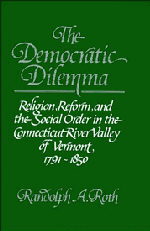 The Democratic Dilemma
The Democratic Dilemma Book contents
- Frontmatter
- Contents
- List of tables and maps
- Acknowledgments
- Introduction
- 1 The revolutionary frontier, 1763–1800
- 2 The failure of the covenanted community and the standing order, 1791–1815
- 3 Religion and reform in the shaping of a new order, 1815–1828
- 4 From an era of promise to pressing times, 1815–1843
- 5 A clamor for reform, 1828–1835
- 6 The great revival, 1827–1843
- 7 A modified order in town life and politics, 1835–1850
- 8 Boosterism, sentiment, free soil, and the preservation of a Christian, reformed republic
- Conclusion: Religion, reform, and the problem of order in the Age of Democratic Revolution
- Appendix A Church records
- Appendix B Types of towns
- Appendix C Occupational groups
- Appendix D Statistical methods
- Notes
- Index
3 - Religion and reform in the shaping of a new order, 1815–1828
Published online by Cambridge University Press: 04 August 2010
- Frontmatter
- Contents
- List of tables and maps
- Acknowledgments
- Introduction
- 1 The revolutionary frontier, 1763–1800
- 2 The failure of the covenanted community and the standing order, 1791–1815
- 3 Religion and reform in the shaping of a new order, 1815–1828
- 4 From an era of promise to pressing times, 1815–1843
- 5 A clamor for reform, 1828–1835
- 6 The great revival, 1827–1843
- 7 A modified order in town life and politics, 1835–1850
- 8 Boosterism, sentiment, free soil, and the preservation of a Christian, reformed republic
- Conclusion: Religion, reform, and the problem of order in the Age of Democratic Revolution
- Appendix A Church records
- Appendix B Types of towns
- Appendix C Occupational groups
- Appendix D Statistical methods
- Notes
- Index
Summary
With the formal separation of church and state in 1807 and the demise of the national Federalist Party in 1815, many Vermonters, particularly those who were Federalists or devout Calvinists, began to fear that their society might become amoral and politically chaotic. Those fears were unfounded, however, for after the War of 1812 church members and like-minded townspeople of all denominations and political persuasions moved toward common ground in their commitments to their communities and to basic moral precepts. They did not come to that common ground consciously, or all at once. Denominational differences and antagonisms remained. Yet differences seemed to pale in importance before threats of immorality and disorder, especially after a massive crop failure in 1816, and the first signs of economic and demographic congestion in the valley.
Agitated by these concerns, Vermonters flocked to the valley's churches and Masonic lodges between 1815 and 1828, strengthening the institutions that gradually helped church members and like-minded towns-people bring a degree of order to postrevolutionary society. The burgeoning churches and lodges fostered networks of mutual assistance among church members and townspeople who shared their values, and those networks subtly helped them gain control over town resources. That in turn enabled them to draw others into their circle and into their campaign to uphold moral standards within their communities. Leading Federalists and Republicans also undertook interdenominational reform movements to bolster efforts to uphold moral standards, and through these movements they discovered new grounds for unity and won new political prestige.
- Type
- Chapter
- Information
- The Democratic DilemmaReligion, Reform, and the Social Order in the Connecticut River Valley of Vermont, 1791–1850, pp. 80 - 116Publisher: Cambridge University PressPrint publication year: 1987


